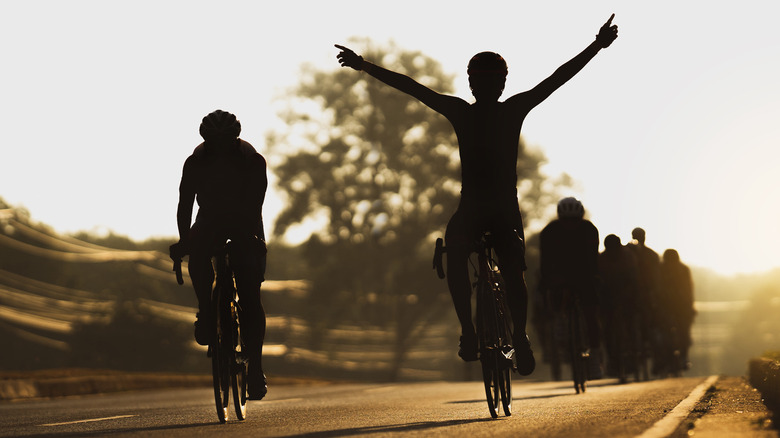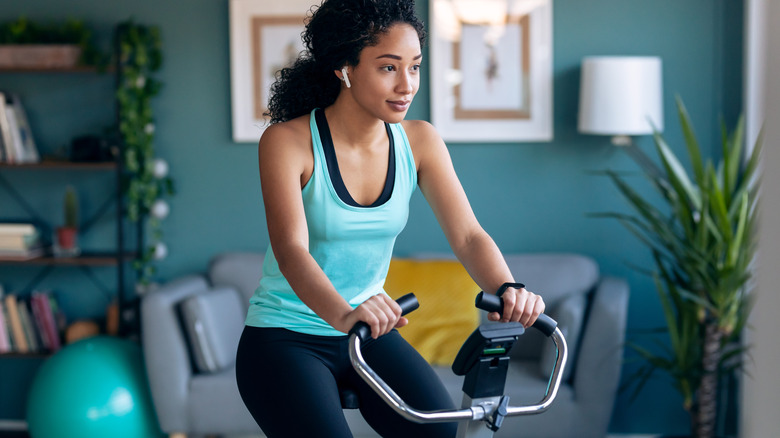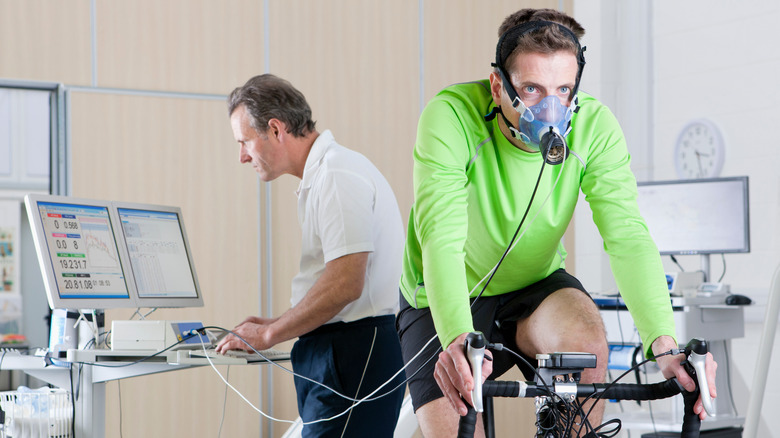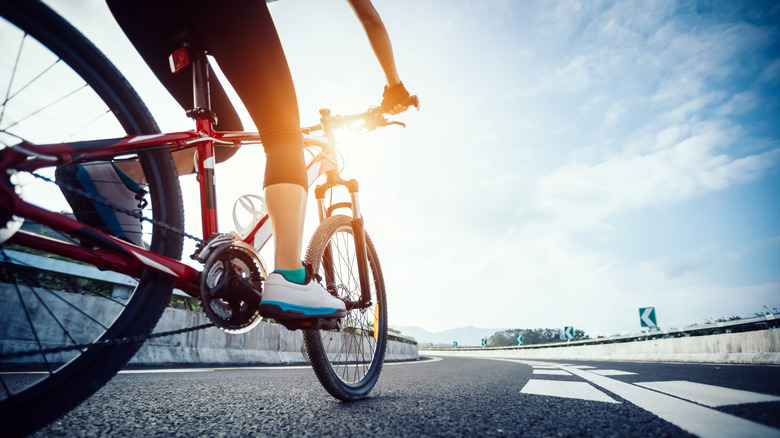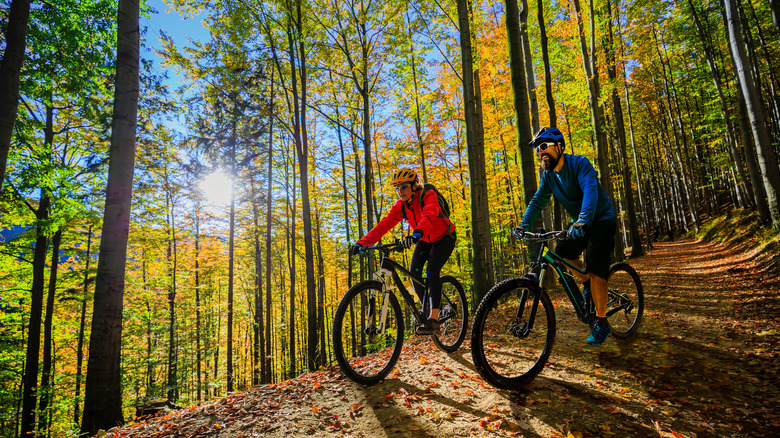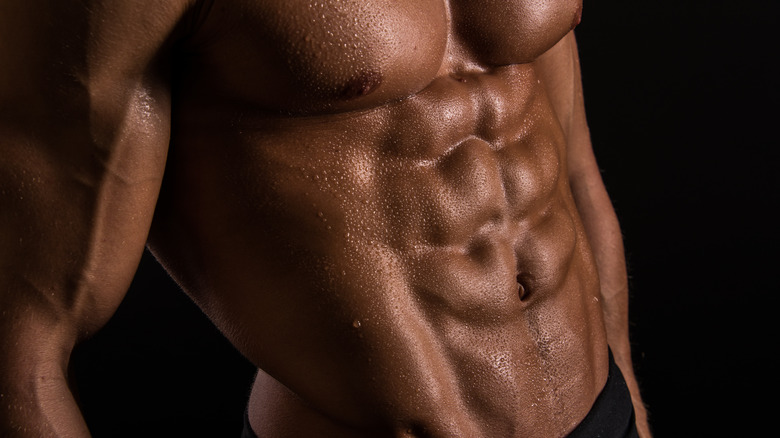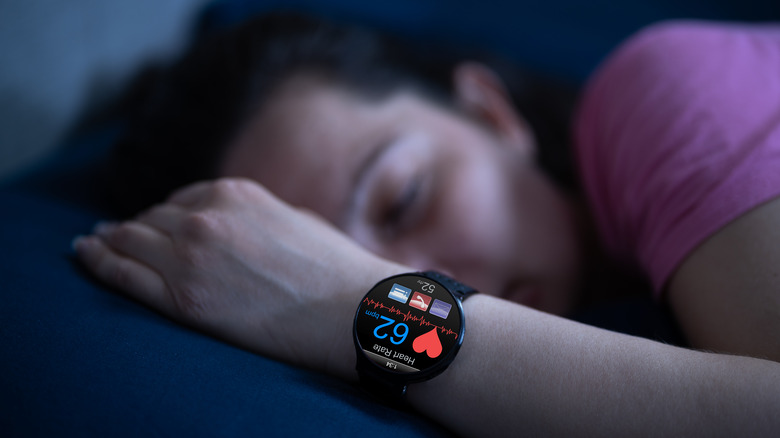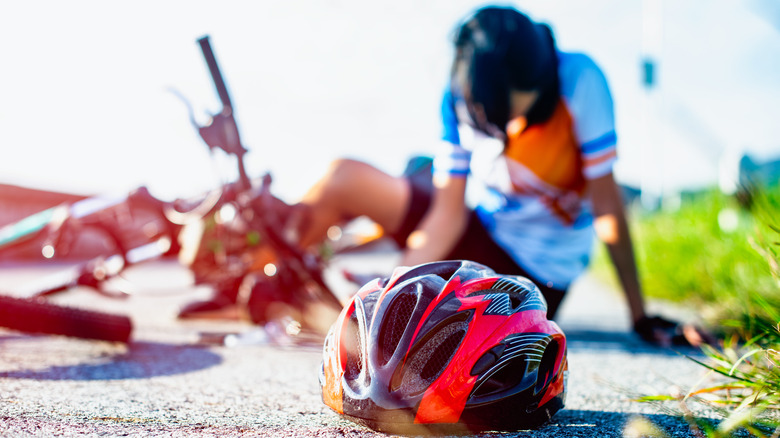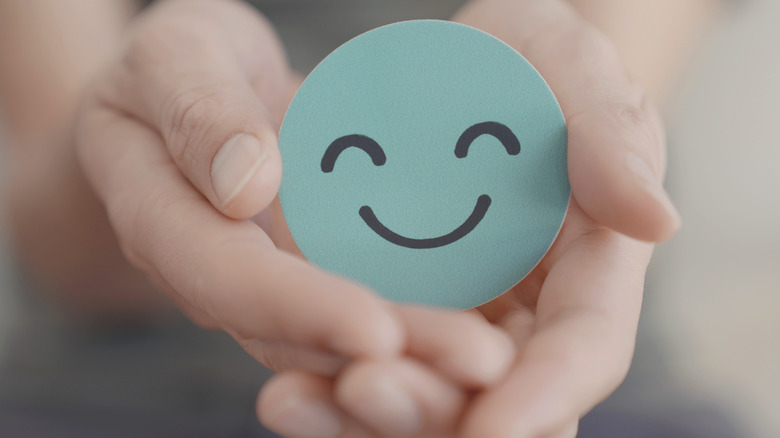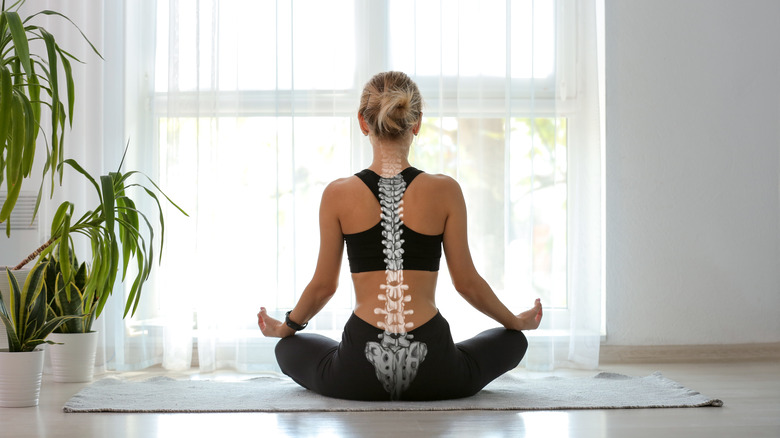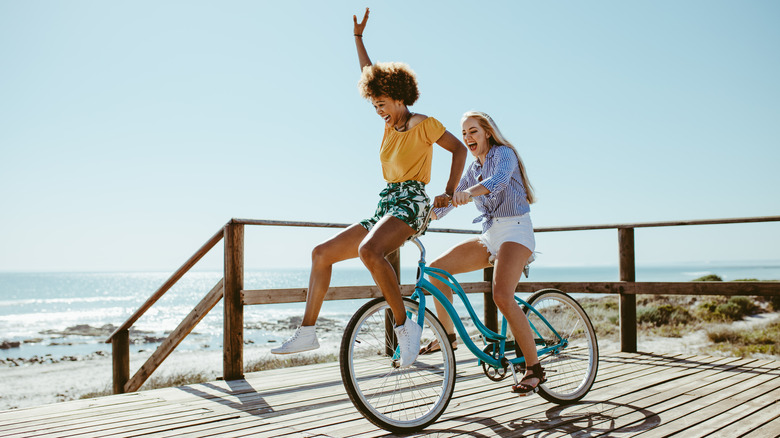What Happens To Your Body When You Ride A Bike Every Day
We know you've considered jumping back into your long-retired fitness routines. After all, as they say, it's just like riding a bike. But then, you might start thinking about bikes and wonder if cycling might be a fun new way to break a sweat.
From road cyclists to mountain bikers to SoulCycle enthusiasts, it seems like a ton of people find joy in riding bikes in some capacity for fitness. While we can venture to assume that cyclists of all kinds have strong legs, we wonder what the health implications of daily bike riding are. Moreover, what kinds of physical and mental health benefits — and consequences — are there from riding a bike every day?
Surely, there is more to cycling than just stronger legs and lungs. We did a cyber-deep dive to unpack what could potentially happen to our bodies if we cycled every day. Our findings, for the most part, made us want to go all legendary Freddie Mercury and scream into the ether, "GET ON YOUR BIKES AND RIDE!"
Indoor vs. outdoor cycling
Hypothetically, you are in a mental space where you feel motivated to commit to riding a bike of some kind every single day. The next step may be to wonder which type of cycling will offer the most bang for your buck, indoor or outdoor. There are many different types of outdoor bikes to ride, but when viewed broadly, both indoor and outdoor cycling offer their own distinct advantages.
For example, from a heart rate training-specific perspective, indoor cycling reigns superior. This is because indoor cyclists do not have to focus on navigating through obstacles and balancing the bike the way outdoor cyclists do (via Health). This leaves indoor riders to focus on the friendly competitive spirit that can be felt in a full spin class, the warm temperature of the room, and the intensity of their pedal strokes.
When we consider perceived difficulty, things get harder to discern. On the one hand, indoor cycling might seem harder because of the monotony of it, but outdoor cycling can bring elevation challenges and more, which are sure to feel harder than the demands you impose upon yourself.
Finally, remember that convenience is a key component when deciding how to ride as well. If you are uninterested in battling the elements, learning how to change bike tires, and finding your way through traffic, indoor cycling is likely to be a better choice for you.
Your lungs will get stronger
Perhaps one of the most astounding benefits of daily cardiovascular activity is the impact it can have on your lungs and their functionality. Your VO2 max can be defined as your body's ability to intake and utilize oxygen, and is closely associated with your physical endurance (per Garmin). The higher your VO2 max, the higher your capacity for cardiovascular work.
One of the great things about cycling is that it is an aerobic activity — and the more often you do it, the greater your ability to take in and use oxygen becomes. When you inhale, the oxygen that you take in gets transferred into your bloodstream, where it is then pumped to your muscles. Once the oxygenated blood arrives at its destinations, it initiates a complex cellular process that ultimately allows your muscles to contract and propel you into your chosen activity.
Thus, by putting your cardiovascular system under pressure via cycling every day, you will be able to increase your overall efficiency and strength of your lungs.
Your circulation will improve
The circulation of blood throughout your body is tethered to the strength of your lung capacity. Improved circulation means that your nutrient-rich blood can move through your body more easily, which can lead to better health overall. Poor circulation to the lower extremities in particular has been associated with skin ulcerations and an increased susceptibility to infections and decreased mobility.
Consistent exercise (and cycling, specifically) can be great to help combat the negative side effects of poor circulation (via Discerning Cyclist). In fact, exercising regularly can increase your body's circulation and the health of your most valuable muscle, your heart. By strengthening your heart muscle, it will become better equipped to forcefully pump blood throughout your body. The most important bonus of improved heart strength and circulation is that it lessens your risk for heart-related diseases.
So whether you are looking to increase the strength of your heart or increase your circulation for overall health, getting out on your bike every day is a great way to start.
Your legs will get stronger
Your lower body is made up of way more muscles than you might think. Each muscle and muscle group carries out their own specific biomechanical function within the body. Unsurprisingly, pedaling away on your bike can strengthen the major muscle groups on the lower body.
The basic anatomy lesson goes like this. You have your quadriceps group, which is the collection of muscles that make up the upper thigh (via Training Peaks). The hamstring group is a different family of muscles that make up the back part of the leg, with the gastrocnemius and soleus below (i.e., your calves). You have three gluteus muscles, with the gluteus maximus being the main powerhouse in that family for cycling. There is a lot more to it than that, but for simplicity's sake, those are the muscle groups to focus on.
As you take your legs through pedal strokes, you initiate the push-power through the glutes and quads. This then parlays into hamstring engagement as the movement transitions from push to pull, which then includes the lower leg muscles. Over and over again, these pedal strokes add up like little, miniature leg presses and can lead to strength gains. These strength gains can translate into better posture and biomechanics over the long term.
You might lose body fat
Losing body weight is not always the goal of exercise, but if it is one of your goals, cycling is a great mode of exercise to scope out.
According to Healthline, bicycle riding can be great for weight loss at many different stages of life, because it is a low-impact cardio option. Cycling is far easier on your joints than higher-impact sports like running. If you have never implemented any type of exercise routine into your life and you want to try cycling every day, you are fairly likely to lose weight no matter the intensity.
That said, there are a few ways to maximize your fat-burning potential while you pedal. The experts at Healthline recommend ratcheting up the intensity, either throughout the entire ride or through interval training. The harder you push (within reason), the bigger the kick to your metabolism and overall calorie-torching benefits. Another surefire way to increase your fat-burning abilities is to extend your ride a bit every day. By putting in a bit of thought and effort, daily cycling is a great way to help you reach your weight loss goals.
Your core will get stronger
We tend to think of cycling as a leg- and cardio-heavy exercise option, which it totally is. But did you know that daily cycling could also help you strengthen your core?
Indoor and outdoor cycling both engage your core in ways that are not glaringly obvious. As you pedal away, the muscles that make up your core get fired up to help keep you stable on the bike (via Healthline). To be clear, the core muscles include all of the muscles that support your trunk, not just the ones that give you a Chris Hemsworth-esque six-pack.
Livestrong conducted an interview with Dari Kruse, the director of education for the National Exercise Trainers Association, who confirmed that cycling with proper form does take some core engagement and strength. Because you need to have strength to maintain the correct posture for cycling (as well as to turn your bike and tackle technical terrain while outside), cycling is a great full-body workout.
Your glutes might grow
Since your glutes are among the powerhouse muscles that get used when it comes to cycling, muscular hypertrophy is an expected side effect of daily bike riding.
Muscular hypertrophy can be simply defined as muscle growth (via Healthline). By imposing demands on your muscles, they have no choice but to react by adapting to the pressures of their newfound stress. The muscle cells grow to support the work they need to perform — and with that often comes visible growth within the muscles.
Your glutes engage with each pedal stroke, thus imposing muscular stress. If you hit the roads (or the Peloton or spin class) on the daily, your glutes will likely grow as a result. The more tension you inflict as you ride, whether by climbing hills or cracking the gear on your indoor bike, the more likely you are to experience hypertrophy of the glutes (via Healthline). If glute growth is your goal, you can emphasize hills, resistance, and even standing as you confront the heavy gear for an extra kick in the rear, literally.
Your resting heart rate might decrease
Unless you are a full-blown exercise nerd, you might not have given much thought to the significance of your resting heart rate. Your heart rate is a tactile way to check in with the health of your heart muscle. While there are outlying medical conditions and other circumstances in which a super low heart rate might not be healthy, in terms of fitness, the lower your resting heart rate, the higher your physical fitness (per Harvard Health).
As you train your body, your heart becomes stronger just like your other muscles. Your heart rate lowers as your heart gets stronger because each pump has more force behind it. This allows your heart to carry out its necessary functions with less effort, which ultimately allows you to be healthier. According to Harvard Health, a high resting heart rate can eventually take a toll on your body — and in some cases, can lead to premature death.
There are a ton of external factors that can influence your heart rate, including things like stress, caffeine, hormones, and certain medications. Even moderate cardiovascular exercise can help regulate your resting heart rate and lead to a more powerful, healthy heart overall.
You might get saddle sores
Let's take a moment and discuss one of the less glamorous side effects of riding your bike every day: saddle sores. If you're unfamiliar with saddle sores, well, we are sorry to be the bearers of bad news here. There are four different types of saddle sores, but they all are born of the same thing. Saddle sores occur where your glutes touch your bike seat as a result of friction and pressure.
Saddle sores from chafing are the most common, as explained by Healthline. If ignored or left unattended, chafing saddle sores can quickly turn into ulcerations. Ulcerations happen when the external layer of skin gets worn off. This leaves an open wound that is more susceptible to bacterial infections. Furnucles and folliculitis occur when the tissues become infected. Furnucles are also called boils, while folliculitis is a pimple-looking infection of the hair follicles.
When you spend a long period of time riding a bike with few shifts in your position, saddle sores can happen. To prevent them, it is recommended that you wear padded shorts, change your position while riding, and ensure that your clothing stays clean. If you suspect that you are beginning to develop a saddle sore, take a few days off from riding to prevent the condition from worsening.
Your mood might improve
As you likely know, exercise can promote the production of mood-brightening hormones. This is one of the reasons why exercise can be so beneficial to our mental health and overall moods. But beyond that, cycling has a meditative component that has been shown to increase focus, mental acuity, and of course, your mood (via Healthline).
Because of the monotonous cadence of cycling, you can find a rhythm to focus on. Whether you choose to bring your awareness to the road, the rhythm of your legs, or your breathing, your mind will be present. The more you practice this, the more adept your mind will become at finding presence.
As you continue to emphasize focus on the present moment, your mind is more likely to automatically deflect the noise and "chatter" from a wandering, stressed, worried, or anxious mind. Taking notes from the 2012 documentary "Happy," we can learn that presence is one surefire way to cultivate a little bit more happiness.
You may improve the quality of your sleep
According to the experts at Johns Hopkins Medical, it is relatively unknown as to why exercise helps us fall asleep and stay asleep. However, these same experts all agree on one thing — that exercise most certainly does have this effect on the human body. They state that moderate aerobic exercise can encourage your body into more restful, slow wave sleep. This is also known as your "deep sleep," which is prime time for your body and brain to recover and rest up.
The best attribute of the sleep part of the equation is that it doesn't take a ton of effort nor Olympic-level workouts to reap the benefits. Sleep expert Charlene Gamaldo, M.D. states that as little as thirty minutes of moderate exercise can help you sleep better that very night. She further explains that while some people might find that heart-pumping, heat-inducing workouts keep them up at night, dialing in your timing is one way to improve the quality and ease of your sleep.
Cycling can help improve your posture
We have established that cycling can do wonders for your core. By maintaining an upright posture and an engaged abdomen as you ride, you will become stronger throughout the center of your body. To expand upon this, you may even be able to improve your posture by cycling (via Healthline). The core strength you create can help you to stand and sit taller with more muscular engagement and less reliance on stacking your skeleton to remain upright.
These postural elements can translate to better coordination overall and a lessened likelihood of muscular imbalances and compensation. Proper posture and gait can reduce your risk of falling and getting injured as you age. Balance and stability are among the first to degrade as we age, which makes maintaining some level of physical fitness all the more valuable as we get older. Since all of this can be accomplished by riding a bike a little bit every day, we see no reason why we wouldn't!
You might lower your bad cholesterol
Cholesterol can be a tricky thing. We have the "bad" kind and the "good" kind (per Healthline). While some of their levels in our bodies are diet-related, regular exercise can help decrease the levels of "bad" or LDL cholesterol in your body. Striking the right balance of cholesterol in your body is paramount to your overall health. In fact, the proper cholesterol levels can help lessen your risk of developing strokes or heart attacks.
Based on a multitude of studies, Healthline reports that consistent indoor cycling may positively affect the cholesterol balance within your body. It can also help regulate your triglyceride levels, which influence your cumulative health as well. These studies have shown links between cycling and increased "good" cholesterol (or HDL) and lowered LDL. The Mayo Clinic states that working up to around half an hour of exercise five days per week is a great way to reap the benefits of balanced cholesterol.
You can improve your energy levels
Exercise affects the makeup of our bodies on a cellular level (via Harvard Health). If you begin to implement daily cycling into your routine, the mitochondria of your cells will adapt. The mitochondria, AKA the powerhouses of the cells, become more robust and functional as you exercise. They are the cellular structures that basically spearhead the process of turning your breath and food into usable energy. The more of these tiny cellular bad boys you have, the more energy your body will be able to generate.
Since daily cycling increases your circulation as well, your blood will be moving and grooving throughout your body with a little more gusto. Your blood can provide oxygen and nutrients to your newly-strengthened mitochondria, which adds the opportunity to create even more cellular energy. Consistent exercise can also give you a burst of energy-boosting hormones, which can add to the energetic feels you'll get if you ride your bike every day (per Harvard Health).

